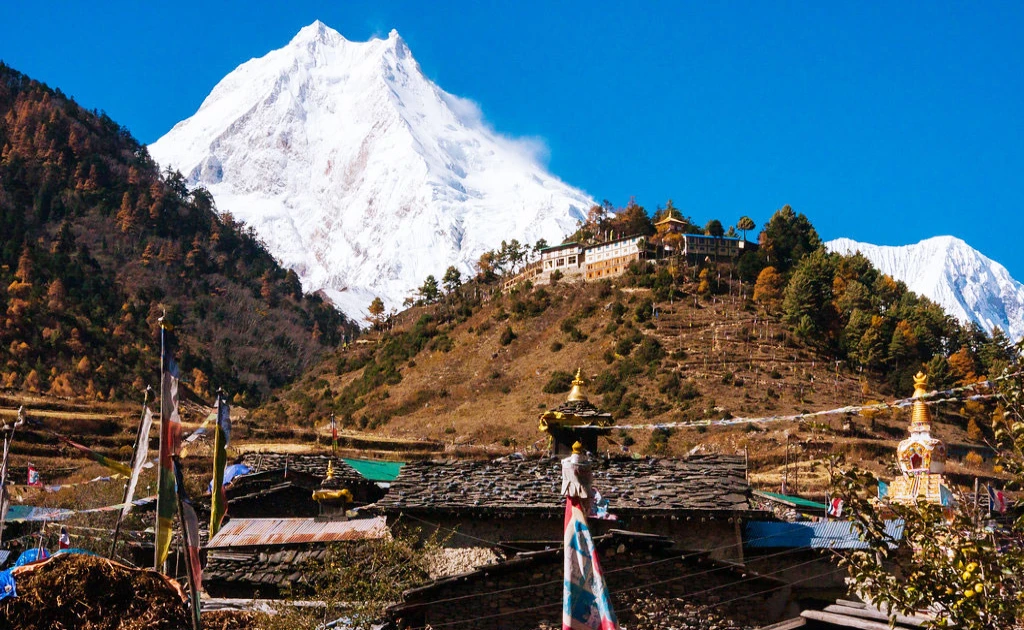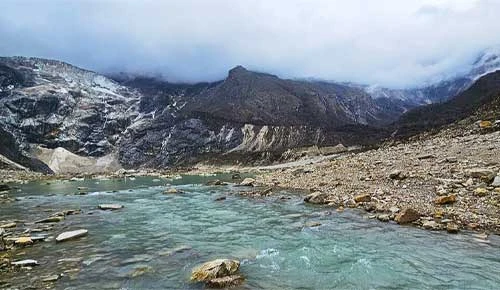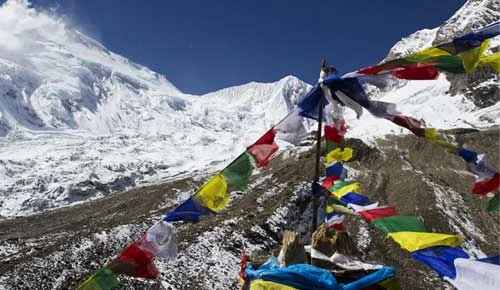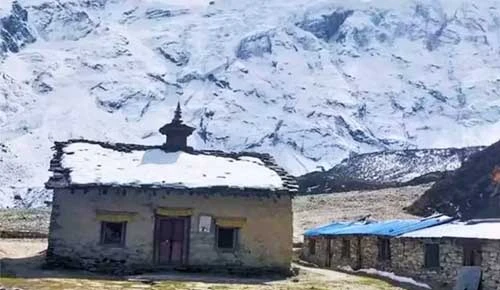Lho Village Travel Guide
Lho is situated very high above Budhi Gandaki Valley and is not simply a halting place on the Manaslu Circuit; it is a peephole into the Himalayan culture and spirituality. The first thing you see when you arrive is the magnificent Mount Manaslu, which looms over the village like a guardian. Stone-laid streets pass between groups of old houses, prayer wheels adorn the walkways, and one can hear the chanting of the monks in the Ribung Monastery floating through the fresh mountain air.
Lho village has a remote authenticity, unlike the busier settlements along other trekking routes. It is a slow-paced place with the locals herding the yaks, weaving, or making butter tea, and kids in the red robes heading to monastic schools. To the trekkers it is a refuge to rest, breathe and feel the harmony of nature and culture and calm down in the presence of both beauty and culture. Crossing Lho with each step, you get not only nearer to the mountains but also near the spiritual tradition that characterizes this unknown Himalayan jewel.
The only thing that is really memorable about Lho is how it connects the magnificence of the mountains and the closeness of village living. In this case, each sunrise above Manaslu is a blessing, each turn of a prayer wheel a hundred-year-old belief, and each smile on the face of the locals the warm welcoming of the Himalayas. A destination that you will remember even after the trek is complete and that the Manaslu journey is a journey not only about defeating mountains but also about finding peace, culture and intimacy within a territory of the Himalayas.
Major Attractions of Lho Village
- Lho Village offers stunning Mount Manaslu views and peaceful Ribung Monastery visits.
- Visitors can stroll through stone-paved alleys and admire the Budhi Gandaki Valley scenery.
- The area is rich in local culture, with friendly villagers and traditional prayer wheels.
- You’ll find alpine forests, terraced fields, and colorful seasonal flora & fauna.
- The sunrise and sunset points provide breathtaking photography opportunities.
- Yak pastures and vibrant cultural ceremonies & festivals showcase the village’s authenticity.
Best Season for Lho Village
Autumn (September to November)
The most popular time to visit Lho is autumn. The weather is normally clear, with spectacular vistas of the mount Manaslu and other mountains. It is steady; daytime is pleasant to trek in; the forests and the valleys are green post-monsoon. It is also at this time that festivals and localized cultural events are underway and thus provide the trekkers with an opportunity to experience the traditional village life.
Spring (March to May)
Another wonderful time to go is definitely spring, and those who love nature would agree. The mountain flowers, rhododendrons, and so on, are blossoming all around, giving the woods a lovely bright shade. The climate and the path situation are all good, and there may still be snow left at some peaks.
Winter (December to February)
There are fewer trekkers in winter, but the trails are peaceful and quiet, and temperatures can go below freezing, particularly at night. The snow could be shed on some portions of the path, and thus trekking could be more difficult. But on sunny days the mountain scenes are clean and transparent.
Monsoon (June to August)
The monsoon season is usually discouraged because of rains and trails being slippery with chances of landslides. The terrain is an oasis of the green and rich world; however, hiking becomes more challenging and dangerous.
How to reach Lho?
Reaching Lho is an adventure in itself since the trail will lead you through some of the most scenic and culturally diversified landscapes of the Manaslu Circuit Trek. The village is approximately 3,180 meters, and you can reach there in many ways, depending on what point you start at:
Kathmandu to Soti Khola/Machha Khola (By Road)
A regular trekker will start with a 7- to 9-hour Kathmandu-Soti Khola or Machha Khola drive. It is a better part tarmac and a worse part rough road along the Trishuli and Budhi Gandaki rivers. There are shared and personal jeeps.
Trek from Machha Khola to Lho (On Foot)
Starting at Machha Khola, the walk slowly climbs up in a series of days, through Jagat, Deng and Namrung to Lho. New scenery can be observed in every stage of the trip, including green forests and waterfalls and Tibetan villages in the Alps.
From Namrung to Lho
Lho is normally reached after a 4-5 hour walk by trekkers who pass through rhododendron forests and terraced fields that have fantastic views of Manaslu and Himal Chuli with Namrung. This is ranked as one of the most beautiful areas in the lower Manaslu region
Food and Accommodation
The calm Manaslu Path greets hikers with a warm affection at Lho village that gives a home-like feel. Family-run teahouses along the trail. They give good spots to stay with two or three beds and warm sheets. They have simple heat too. They greet walkers each day. The rooms are small. Yet the true warmth from the kin makes it feel like home. This makes guests feel as if they are part of the village group. Multiple lodges feature common spaces where trekkers can unwind to exchange tales or enjoy the peaceful mountain environment as the sun dips below the snowy mountain ridges.
The food at Lho offers trekkers a nourishing combination of wholesome ingredients, which provides essential energy for their upcoming hike. The traditional Nepalese dishes Dal Bhat and vegetable soup along with Tibetan bread and momo and noodles receive careful preparation and you can enjoy hot drinks of milk tea and butter tea and ginger tea for internal warmth. The availability of quick snacks like biscuits and chocolate and instant noodles provides convenient options between your main meals. Lho has just a bit of power and weak phone signals. But guests will enjoy its good food & warm places to stay. The hosts are nice, and they create a strong connection with life in the Himalayan village.
Things to Do in Lho Village
- Visit Ribung Monastery and observe monks doing rituals.
- See the sunrise and the sunset on the mountain Manaslu.
- Wander through village alleys, which are paved with stones and prayer flags.
- Meet local villagers and get to know about Himalayan life.
- Take the loveliness of the alpine woods and terraces.
- Take short walks to have the panoramic Budhi Gandaki Valley view.
- Experience local festivals and cultural ceremonies
- Taste traditional meals and hot drinks in village teahouses
- Take countryside walks and go birdwatching in the village.
- Observe yak pastures and mountain livestock
- Spin prayer wheels and soak in the spiritual atmosphere
- Take a rest in the village and relax in the peaceful mountain atmosphere.
Available Packages
Nepal Trek Adventures (NTA) is known for making Himalayan journeys smooth, safe, and unforgettable. With a team that understands the mountains and local culture deeply, they focus on guiding trekkers through the trails while highlighting the beauty, traditions, and stories of each village. From offering helpful advice to sharing insights about the region, NTA creates an experience that feels personal, authentic, and well-supported, helping travelers truly connect with the Himalayas. Here are some packages:
- Manaslu Circuit Trek - 13 Days
- Manaslu Express Trekking - 10 Days
- Manaslu Tsum Valley Trekking
- Manaslu Circuit Luxury Trek
- Manaslu Base Camp Trekking
Final words
Lho is not only just a check-off on the Manaslu Circuit, but also the place where mountains merge with local culture and the simple life of the Himalayan village interconnects so perfectly. Imagine a golden morning sunrise along Mount Manaslu and the gentle song being sung at Ribanging Monastery—with each second, its feeling in the present is calm and momentous. There is adventure, culture and quiet all in a single place as Lho takes a stroll through the stone-paved lanes, breaks a bowl of food with the locals, or just enjoys the freshness of the mountain air. It is not to follow a pit stop by trekkers, but it is to be remembered that here, high in the Himalayas, was where life was beautiful and exciting.




